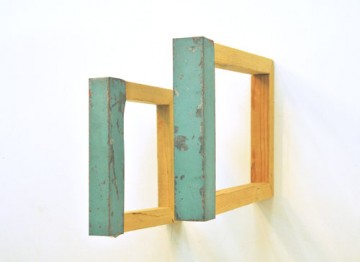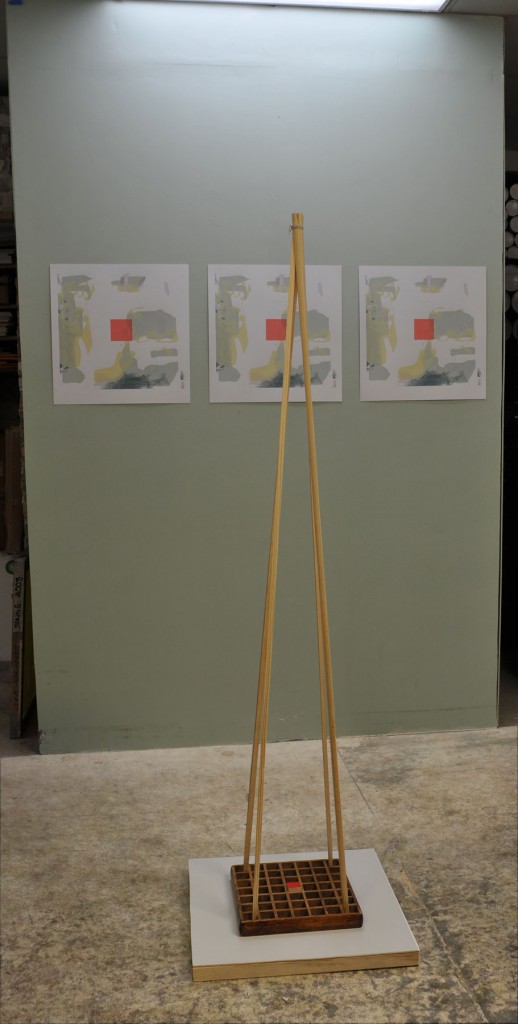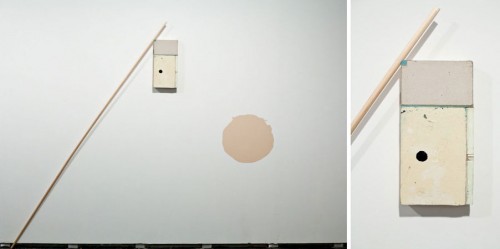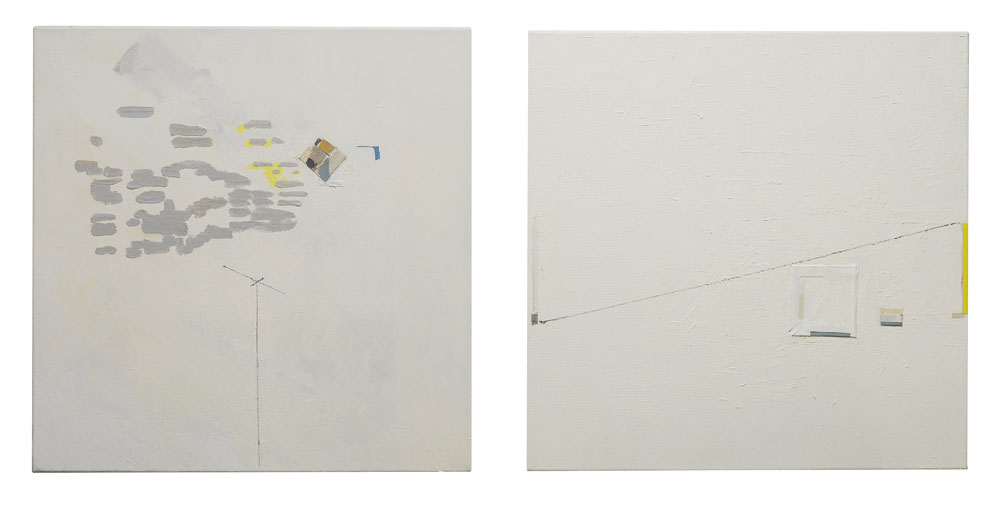Nadine Nakanishi has been working with Nick Butcher in their collaborative independent print shop since 2005. Under the shared moniker, Sonnenzimmer, they’ve made posters for such notables as Beach House, The Books, and Broken Social Scene. They also make posters for comedians, design shows, and the like. While I’ve been consistently astonished by Sonnenzimer’s dedicated success, Nadine and Nick mustered additional energy to kickstart a Creative Printer’s Guild. Through that network, screen printers are able to troubleshoot, share resources, and develop a community around their interest. All of that is of itself worth note: starting a business is not easy; neither is facilitating community. Nevertheless, Nadine manages a personal practice in addition. She is a painter, a sculptor, and (of course) a screenprinter. Here, too, she has a distinct voice. Everything she makes is perfectly placed, perfectly balanced, and often with a distilled or sun-bleached pallet. Embedded in her highly aesthetic objects is a research-based practice. Like poetry, each element in the work is purposeful, abstract, and pregnant with meaning. Consistent throughout those facets of her work lies a buoyant optimism–what I think she’d call pragmatic; and although her work manifests itself differently, there is an underlying foundation of careful, political thought. Last year, I remember there was all this buzz around the artist being the “new entrepreneur.” While I don’t know what to make of that contraction, I do think Nadine epitomizes a self-made, conscientious spirit.
Caroline Picard: How did you start Sonnenzimmer?
Nadine Nakanishi: Sonnenzimmer started as a consequence of Nick, my partner, and me getting together to share art space. We both had separate painting studios and we thought that, through sharing resources, we could get more and finally print out of our own space. At that time, we both were printing out of Jay Ryan’s shop, The Bird Machine, and we were starting to overextend the invitation to use the shop. When we set up our studio, we worked part-time jobs not thinking of anything else, but eventually here and there a poster job helped pay the rent. Those jobs increased a bit, which lead to the next uncertainty, could we even work together? Would there even be a space for our visuals to make it commercially? And as those two things intensified, we slowly started formulating the idea of Sonnenzimmer. This will be our fifth year in business and it’s still much of an experiment, honestly.
CP: How do you go about differentiating between your own work and the work you do in the screenprinting studio, as a collaborator? I’m also curious about how you integrate sculptural elements with screen printing elements.
NN: To answer the first question, my own work feels a lot more naive and unrefined. I work very differently when collaborating with Nick on a poster. When alone it’s like being a kid in a way, walking down the same path you always walk down going home, but then you get side-tracked and you find something amazingly new that you haven’t seen before, something you would share with your invisible super buddy. That’s the kind of thing I like to be connected to. That’s a bit of the energy side of it. From an intellectual angle, it’s questioning the form. What form does a certain medium carry? What’s the content point of the carrier and why that form? What extension of reality is manifested in the materiality of a thing, and why that form? When working with Nick, it’s very different because we usually have to put [a project] into a framework that honors many angles: Nick’s approach, my intentions, the functionality, the cultural notion of what’s expected… However, I always find form is a certain common denominator in that discussion, kinda like a “How-do-you-do” does for a colloquial intro.
The second question is super fascinating to me because certain sculptural discussions are always looked at from a 3D perspective, but when [a sculpture is] experienced, it’s usually in profile, flattening the reality into an illusion. So, understanding a certain expansiveness comes from the medium itself. You use ink, this very physical medium, and then you press it flat onto the paper. This process happens again and again. Once you’ve killed the 3D elements of it in production, you finally have a flat result. Then you hang the poster up in a certain space outside and suddenly it has a sculptural dynamic because it became an object to hang. There’s a side angle, there a lighting difference, there’s the hanging of it. The connection between the two are important to make a poster effective, so I’ve always been trying to explore those two connections where it’s tapping into a physical memory yet using the mental image to make the connection.
CP: Would you talk a little bit about the Chicago Print Guild you and Nick started–how is that structured and how did it come about?
NN: In truth, yes we started it, but we only organized meetings and kickstarted it for the first 8 months. The effort of making it official was the combined effort of all the members willing to take part in it and vote on a board. It’s very important to put that into a context–it was a collective effort formed through a collective need. As an organization, we are still at the very beginning and much is still being worked out. In fact, I don’t know if it will last because it will take an active core of members and it’s deflated a bit thanks to having a board. CPG is a not-for profit, with four board members, a president, Jason Teegarden-Downs, an assosciate director, Ryan Kapp, a secretary, Angee Lennard, and a treasurer, Nick Butcher. We have 20 members in average coming to the monthly meetings and have over 70 people in our Google group to exchange resources. We have an annual membership fee that is very low and more symbolic then anything else. Everyone is expected to serve on committees and be an active part in the Chicago print landscape. Field trips and other events are pay as you play.
It came about that Nick and I went to all these print shows and we never got to really talk shop or hang out with other printers. It made sense because usually all printers are just cranking away but it did make us want to figure out a way how to meet those people behind the printing. Secondly, there is a huge printing culture in the city that gets looked over. And it’s up to us to create a surface so people are aware of it. There are so many small shops and community resources available. All these printers self-publish in many ways. There is so much talent that many institutions, as well as the city, are disconnected from it. It’s for our own job’s sake that we need to band together to make ourselves heard. The beautiful thing about printmaking is that there’s enough room for everyone. Everyone is in competition and nobody is. It’s been really awesome to see that there’s a need for such an organization that bridges the gap between industry and academia.

Nadine Nakanishi, "Greenbars of Suprematism," 2009. Aluminum typecast, canvas stretchers, 20" x 20" x 4" each.
CP: You also have a background working at Punk Planet, right? How would you say your experience there has impacted the decisions you have made since?
NN: Punk Planet was a very formative point in my life. I feel I got this amazing dosage of entrepreneurship through the lens of punk rock. Punk Planet was a very big part of my life. At the time, I just had just come out of school and really felt discouraged by not being connected to the right people and the right resources. But then Dan Sinker, the head of Punk Planet, not only gave me an internship but also invited me to work on the design team. The team was so inspirational. We called each other out on every bullshit we created while laughing at each other and just trying to do better. Every other minute I had, I wanted to help out there, filing subscriptions, taking out the trash, and it was such a magical circle of people to be around. Punk Planet was sharing a space with the Bird Machine back then, and in between the two, nobody cared about any excuses. It was about figuring it out. Make more, try harder, don’t think what you can’t do, think what you can do. Dan was very encouraging, teaching me the lesson that my voice can have a valid point if a discussion is important to me and I make it heard. That I had to put my efforts into the community. He also taught me to not wait for anyone else to help me out. He and Jay live the do-it-yourself motto, while still being generous to the community. All this made Sonnenzimmer happen and helped Nick and me get over our egos. We seriously wouldn’t be here or have met if it weren’t to Punk Planet and The Bird Machine.
CP: How do you think about screenprinting as a form? I mean, of course it has all of these connotations as a kind of democratic, utilitarian vehicle for information. At the same time, that’s changed, right? With the digital age and printing what is now….where do you locate yourself within that conversation?
NN: That’s a question that we are very challenged with, as our business is set up in that very dilemma. Funny thing is that since media has become intangible in many different ways, and a physical vehicle is not needed in many instances for a monetary transaction, at the same time, “the image-based culture we live in makes the image as important as content.” And I am quoting Nick here, as we had this discussion in context with another interview we did. It’s weird, but if you look at how many PR firms are growing in contrast to Creative Agencies, it makes you question those intersections. The conclusion is, as these things are vanishing (for example, posters), musicians are more engaged with their albums and posters. See Kanye West’s new album, for example. While they don’t produce as much, they use it as a hype machine for publicizing their image. Nick and I aren’t afraid to sell shop, because at the end of the day, we use the press to self-publish the images that nobody will. We paint because it’s very lo-fi and direct. Image making can happen in many different ways. Form won’t go away, content neither. Images are content and form, so we’re lucky.
CP: In the past you and I have had conversations about setting up almost utopian business-models, you know, like if there can be a utopia within a capitalist structure–I guess I was just interested in how you balance the practical aspects of your business with your idealistic impulses, and maybe even how those idealistic impulses influence your work…..
NN: For me, money has always been a physical means for honoring someone’s time, resources, or infrastructure. I take money very seriously because I look at it as a token. If you give me one dollar or 50 dollars, it’s a token that I received and with it comes with a certain discussion. While there is a way to honor time in different ways, in my experience, money is often also an easy excuse not to find multi-faceted solutions. It’s not about no money or all money. It’s all of it together. I take this example — if you move to Alaska into the wild, the first thing you do when you have an infected wound is run back to civilization. You need to know your freedom is based on everyone else who is carrying the infrastructure on which your freedom is based, saying yes to the system even if they don’t want to. And for us, paying an intern means figuring out a model where we can honor that person’s time while understanding the token we give is not enough. Hiring someone 3 months at a time and then letting them go, or having someone come in for a summer break and then that’s it, isn’t going to be a long-term solution in helping that person form an in-depth picture of the struggle balancing the different economic structures you have to maneuver through. We don’t have the luxury of being idealistic; we are pragmatic. When you are at the poverty line, you understand that idealism is luxury. That understanding makes you very aware of the battle. If we are doing business and have to bow, we don’t want to bow to a business model that isn’t invested in a fair exchange. That for us means paying and understand that we are underpaying and thus need to throw in other fair incentives that honor the trade. If we figure out a way to pay an intern, it means that we figured out a sustainable path to have someone at the shop for longer. It implies that we have given up some of our notions of money to share it. That we understand that we can’t fully compensate the contribution but want to equate it in more then one way.
Companies think you can hire someone for 20 years with a paycheck and that’s enough. It’s not. That someone put their lifetime in for someone else’s dream, someone else’s mortgage, so the balance can never be even, you have to do something additional to honor that part as well. And that ends up questioning the traditional balance sheet of economies. Is outsourcing labor and using natural resources of a country indexed on the balance sheet? I don’t think so — that is why a traditional balance sheet isn’t a real reflection on cost. For example, how much water does Budweiser use to produce a can of beer? This water is coming from somewhere. That is common good. So paying taxes is in one part of that balance sheet. But if you depleted the water resources of a certain area, you will have to come up with an additional way to make up for what was depleted.
CP: How would you describe your relationship to this city? I know you’ve lived all over the place, and I feel like you incorporate aspects of your unique (and global) background into your work–nevertheless I feel like there is something very specifically Chicago-ish about what you do–maybe just that your ethics are somehow in league with this city…could you talk a little bit about that?
NN: Chicago has been amazingly generous to me. The arts in this city are very a powerful tool. Because Chicago is so segregated, the arts are the only place left where we can all culturally meet with all our differences – if you are commercially orientated or not – if you are from a different ethnic background or not, and so on. It’s no wonder this city has such rich intersections between music genres, writing and performance, performance and visuals, science and architecture, design and economics… I feel a very strong connection to this potential. As I sometimes was at loss for words explaining my history when I was younger, I’d say, I’m not sunny side-up, I’m kinda like scrambled eggs.

Nadine Nakanishi, "Perspectives: The Shelf and The Drift," 2010. Wood sculpture & screenprint 6ft x 24" x 24".








Pingback: Interview with Nadine Nakanishi | The Lantern Daily